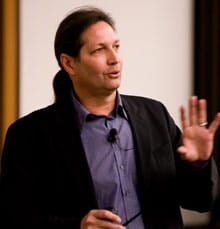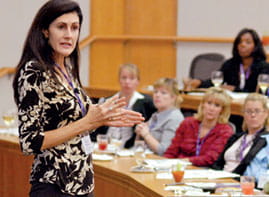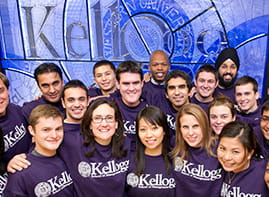5/8/2008 - “Leadership is the constant that makes businesses successful, regardless of the products and services they offer,” said Jim McNerney, chairman, president and chief executive officer of The Boeing Company.
With a focus on the importance of leadership, McNerney discussed what he called the “five great myths of innovation” during an April 30 keynote address at the 2008 Manufacturing Business Conference. The student-led conference brought students, faculty, staff and distinguished guests to the James L. Allen Center to discuss this year’s theme: “Differentiation by Design.”
“We’re trying to develop general managers for product-focused companies — not just focused on the operational side of business,” said conference co-chair Clint Collins ’08, a student in the MMM Program.
In his remarks, McNerney dispensed with the idea that innovation is just for technology savants and eccentric geniuses. “Innovation is a team sport,” he said. “Everyone can innovate and everyone should.” Most innovation is done in small steps, he explained, and these incremental improvements can come from any company division.
Another productivity-killing myth, McNerney said, is that “creativity and discipline are mortal enemies.” Discipline — in particular, a system for vetting ideas — keeps a creative team focused on the ideas that best meet its customers’ needs and support its business: “You can’t have creativity without discipline because, like it or not, not all ideas are created equal.”
Following McNerney’s address were two breakout sessions for panel discussions. Among the choices for attendees were “Rapid Innovations: Fast Failures” (moderated by Larry Keeley, an adjunct professor of management and manufacturing) and “Returns in Middle-Market Private Equity Investments: Where Finance Meets Operations” (moderated by David Matsa, an assistant professor of finance).
In “What’s Next? Where Do U.S. Manufacturers Go From Here?” Associate Professor Benjamin Jones moderated a conversation about the effects of the global economy on U.S. manufacturers.
 |
| Sam Lucente, the vice president of design at Hewlett-Packard, delivered a keynote address at the 2008 Manufacturing Business Conference. |
| Photo © Nathan Mandell |
As production costs in China rise, some companies are scouting Asia for cheaper labor markets. But panelist Margaret MacLean, the vice president of manufacturing group MacLean-Fogg International, said an exodus from China seems unlikely. “It’s not so simple as, ‘China’s getting more expensive, so we’re rushing from one market to another,’” she said, pointing out that quality and labor concerns may take precedence over cost for many companies.
Panelist Scott Santi ’94, executive vice president of Illinois Tool Works Inc., said growing companies will have to consider setting up shop closer to the markets they serve: “Simple and flexible and local is going to win. There are no scale advantages anymore.”
McCormick School of Engineering Professor Bill White moderated “The New General Manager” panel, in which participants discussed strategies for uniting a workforce often half a world away.
“The biggest problem I have is being able to find that time to speak one-on-one with some of my senior leaders around the world,” said panelist Tom Goesch, managing director for power electronics and hybrid electric vehicle products at Delphi Electronics and Safety, adding that he prefers to alternate morning and evening meetings between his team’s U.S. and Asia contingents.
Panelist Jeff Bougher ’02, president and chief financial officer of Indiana startup M4 Sciences, also emphasized the value of communication to a general manager. “You need to have a plan,” he said. “You need to be able to explain it. You need to be able to tell your story.”
If the role of the general manager is in flux, so is the designer’s role. Afternoon keynote Sam Lucente, vice president of design at Hewlett-Packard, said design is just starting to come into its own.
“Design as a profession is where marketing was in the ’50s,” said Lucente. The Kellogg School, he said, has since “put science to marketing” — identified patterns, models and measurable strategies. “The same thing is happening to design.”
As concerns about the environment and rising energy costs create ever more discerning consumers, said Lucente, designers are charged with creating energy efficient, environmentally friendly products, and integrating them seamlessly with the services the modern consumer also expects.
“We have to get much better at building business practices around these unmet, unarticulated needs,” he added. “We are entering this amazing era of innovation.”
Final keynote Iain Roberts, co-leader of the consumer experience design practice at the Chicago studio of global design firm IDEO, agreed, but said few companies have really mastered the art of product and service design.
“Everybody comes to us and says, ‘We want to be Apple,’” said Roberts, adding that the desire stretches across all industries. He noted that one manufacturer told IDEO designers, “We want the iPod of frozen meal solutions.”
The drive to emulate the Cupertino, Calif.-based computer company doesn’t come out of nowhere, Roberts said. It comes from Apple’s attention to the “customer journey” — from packaging to bundled services: “It’s about how something looks, how easy is it for a customer to use and how is it made.”
An audience member asked Roberts whether consumers — who have more power than ever to dictate their design preferences — might effectively turn the traditionally top-down economy of design on its head. Roberts said unidirectional systems of design — be they top-down or bottom-up — may be yesterday’s news: “What we’re intrigued about is what happens in the middle.”
The conference concluded with a networking reception.






